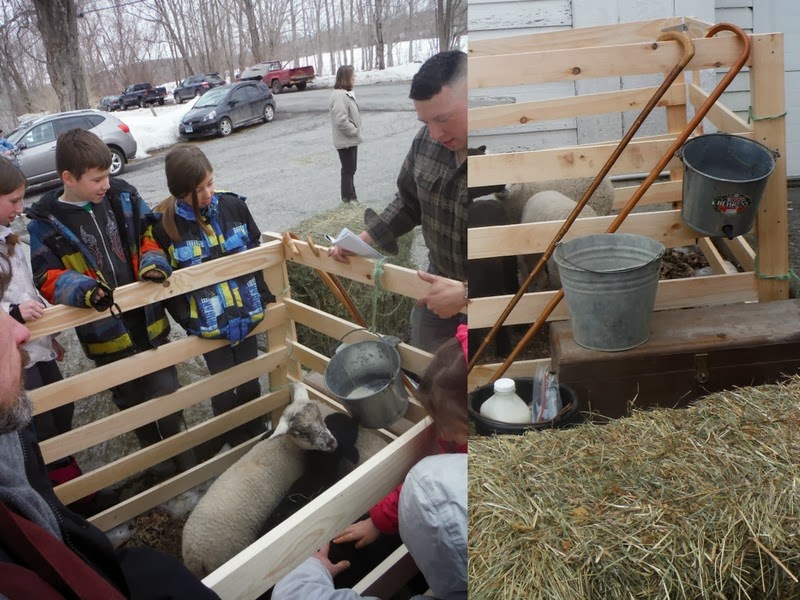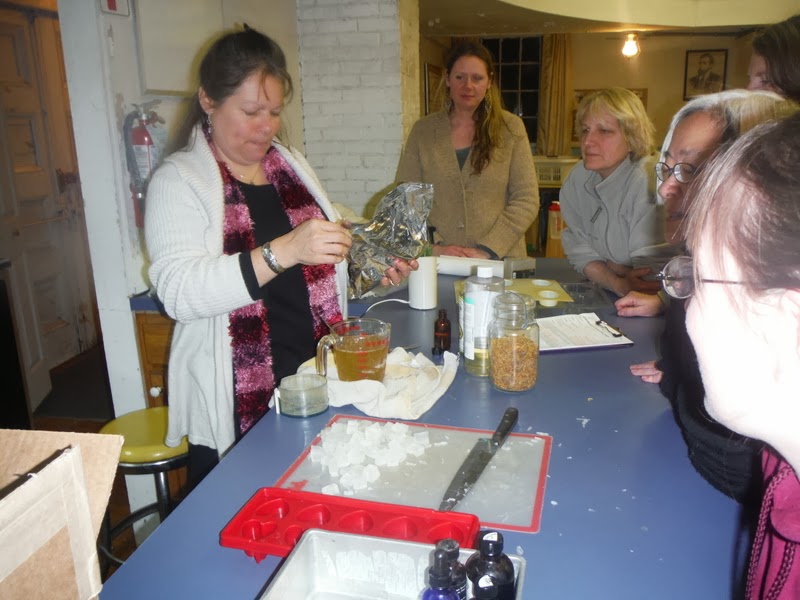We met at the
Taghhannuck Grange hall for an evening of fun and lather...
Sharon Laughlin of
Made for You soaps started off the evening by demonstrating how to use the cold water lye process to make Gardeners' Soap with a natural degreaser... coffee! She makes a batch of coffee and freezes it in ice cube trays. Wearing rubber gloves, a surgical face mask, and full plexiglass face shield, she sprinkles the correctly measured lye over the ice in a heavy duty plastic pitcher. The lye melts the ice and the resulting mix is around 100 degrees. Sharon lets it cool as she warms her oils.
When oils and the coffe-lye mix are both between 80 and 98 degrees she
mixes the coffee-lye into the oils and blends with two(!!) hand held
blenders...

.
...until the mixture thickens and begins to "trace." Then, she stirs in ground coffee beans and pours the whole mixture into molds.
She has beautiful hand-made molds of Corian scraps leftover from her husband's kitchen business. The ends pull out so she can easily push the soap out after it hardens. To prepare the molds, she slathers them with mineral oil, lines them with parchment paper, and oils the paper.
Once the mold is full, she covers the soap and wraps it up in a blanket to keep warm as the lye and oils interact or saponify.
In about two days the soap will be ready to slice. Again, Sharon shows her clever use of Corian scraps with her own home designed soap slicer. Once sliced, she'll label the soap with the date and recipe and lay it on racks to cure for 6 weeks. She uses ph paper to check for when it is fully cured and safe to use... around ph7.
Then I talked about making milk soap and using lard instead of vegetable oil. You can
see last year's post for information about that.
Next, Alicia North of
North Star Botanicals showed us how to use melt-and-pour glycerin soap base to make "Earth and Ocean Lemon Grass Soap."
First she used a knife with a big blade to cut the block into cubes and put them in Pyrex measuring cups.
Then we heated the soap cubes in pans of boiling water until it melted.
Alicia added castor, jojoba and avocado oils to the hot liquid base. After the mix cooled slightly, she stirred in ground calendula blossoms for a golden
color that won't spoil or turn brown and skin healing
properties, kelp powder for additional minerals, and essential oil of lemon grass for the lovely scent
as well as its antimicrobial/antibacterial action. Alicia warned us to be cautious with
lemongrass on delicate tissue! We then poured the mix into molds...
... spritzed them with rubbing alcohol in order to break any bubbles on the surface, and took them outdoors to speed-cool.
To get them out of the molds, Alicia puts them face down on a cutting board and (VERY) firmly presses from outer edges toward center of each mold until the soap releases.
Finally, for a soothing wash for poison ivy sufferers, we stirred a decoction of jewelweed into another batch of melted base. I harvested the plant late last summer and simmered it in water for about 20 minutes, strained out the plant matter, and froze the brew. We added about 1/4 cup to a pound of soap base.





























